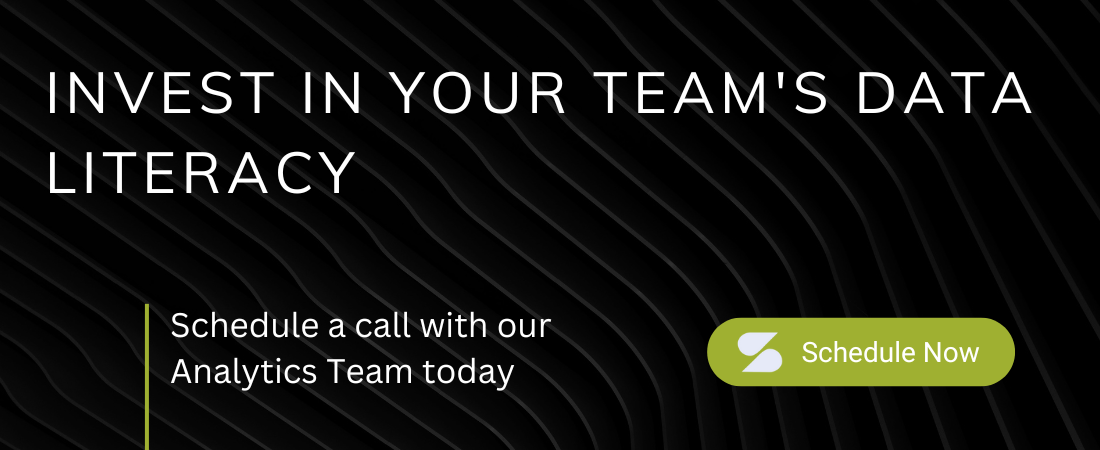The first resume I ever saw was my mother’s. It was printed from our Commodore 64 on a dot-matrix printer. Prominently featured at the top was typing speed in words per minute – right along with age and marital status (oof). Can you spot the five things that are outdated in this paragraph alone?
It’s been a while since typing speeds were so prominently featured on most resumes. It’s assumed at this point that people can type quickly on a qwerty keyboard. At some point, words per minute became Microsoft Office and Excel skills. But even those have become assumed skills. Not everyone is an Excel super user per se, but most working professionals have basic proficiency.
This is a trend with technical skills. As technology makes a certain task easier, more and more people are assumed to be proficient in that task. So now that typing and Excel are table stakes, what’s the next skill that all professionals will need to have?
Data literacy.
Data literacy has the potential to be the next frontier in workplace skills – but not just for people who work in data. To remain competitive, businesses will need to increase data-driven decision-making. And for leaders to maintain their influence and impact, they will need to be able to support this organizational imperative.
What is data literacy?
The best, and perhaps most popular, definition of data literacy is from Rahul Bhargava and Catherine D’Ignazio, who describe it as “the ability to read, work with, analyze, and argue with data.”
This doesn’t mean that everyone needs to be a data scientist or learn data languages like Python and R. But for the everyday professional, we are shifting into an era in which you should be able to…
Read basic visualizations like bar charts and line graphs
Understand the difference between leading and lagging metrics
State opinions while backing them with real numbers
Be current on some of the latest advanced analytics applications (AI, ML, NLP, etc.) and the impact they can have within your department
Data literacy is also about making a decision— and choice—to care about data. Data stewardship is no longer just the responsibility of IT or the data or business intelligence team. It’s the responsibility of all leaders. (It’s like cleaning up after yourself in the break room – you don’t just leave your spills and messy dishes for the cleaning service.)
When people understand how data can really help them in their day-to-day, they realize the care they must take in doing their part to ensure it is complete, consistent, accurate, and dependable.
So what’s the lay of the land right now in terms of data literacy? From a 2021 study, 90% of business leaders say data literacy is a key to their company’s success, but only 25% of workers feel confident in their data skills. And while this number will rise, it’s important to keep in mind that what it means to be “data literate” will shift. Today, it’s important to be able to read a graph. In the not-too-distant future, everyday users will rely on the self-service analytics capabilities of tools like Power BI and Tableau to pull their own reports and even perform some more advanced functions, like forecasting and “what-if” analyses.
Investing in your team’s literacy
There is work to be done when it comes to data literacy, and for now it’s a gap that must be filled by the industry. But it’s more than just an obligation; it’s an opportunity. Consider the benefits of investing in your own, and your team’s, data education and literacy:
- Businesses shift from gut-based activities to data-driven
- All employees begin to have a shared understanding of foundational data terms, approaches, and methodologies and how data fuels overall company focus areas
- A true top-to-bottom data-driven culture begins to build
- The effectiveness of data-driven decision-making increases by ensuring that decisions are guided by an accurate read and analysis of data
- It makes the company a more attractive employer, as these skills are valuable for the professional development of the team
Here are a couple of easy things you can do to get people to adopt more of a data-driven mindset:
- Data Shout-Outs: Provide little rewards or incentives for when employees use data in meaningful or interesting ways. These work best when they highlight accomplishments of individual contributors from the business side – unsung heroes who can be turned into data champions for their peers.
- Quick Tips: These have been an IT staple for years – every so often you’d get a message describing some interesting shortcut or feature you might not have been aware of, like how to take a screen snip using the snipping tool. The BI team can do something similar for Excel, Power BI, Tableau, or any other data products used by the business side.
- Chart of the Week: Inspired by KnowBe4’s Scam of the Week blog series, this is a light lift for the data team that can help people become data-aware and increase transparency. Weekly (or monthly, or at whatever cadence you’d like), send a data visualization to the company and ask folks a question based on it. You can even place the names of people who responded correctly in a hat and pull one person to win a prize.
The competitive companies of tomorrow are going to be data-literate, data-driven, and data empowered. If you lead an organization or a team, how many of your people would you say meet the definition of data literate, as mentioned earlier? As an individual, do you feel you meet that definition?
Ready to invest in your team’s data literacy? Drop us a note with your availability to schedule a call with our Advanced Analytics team to get started.


